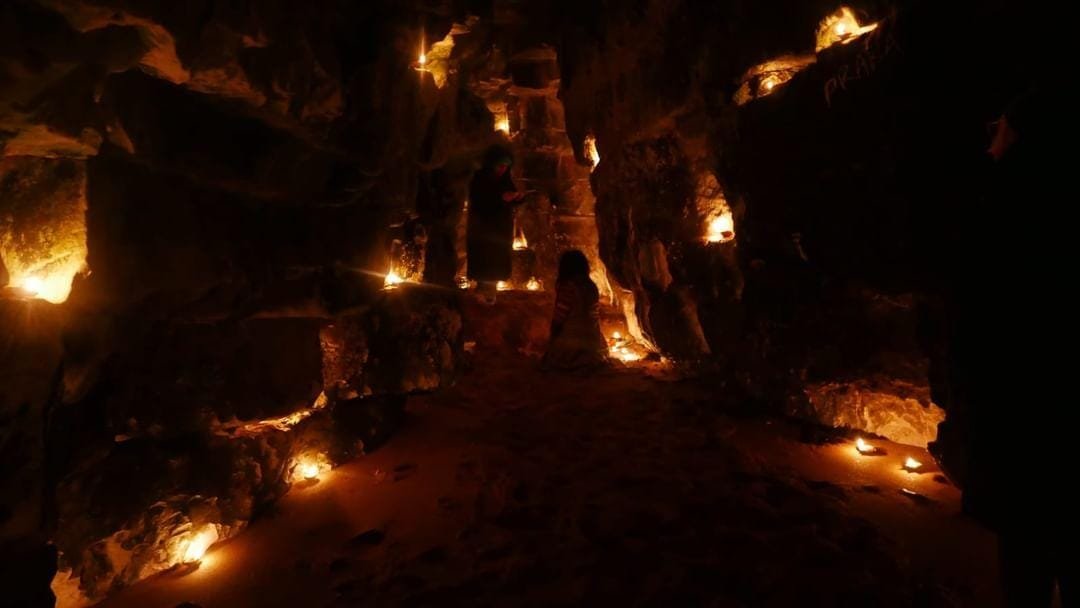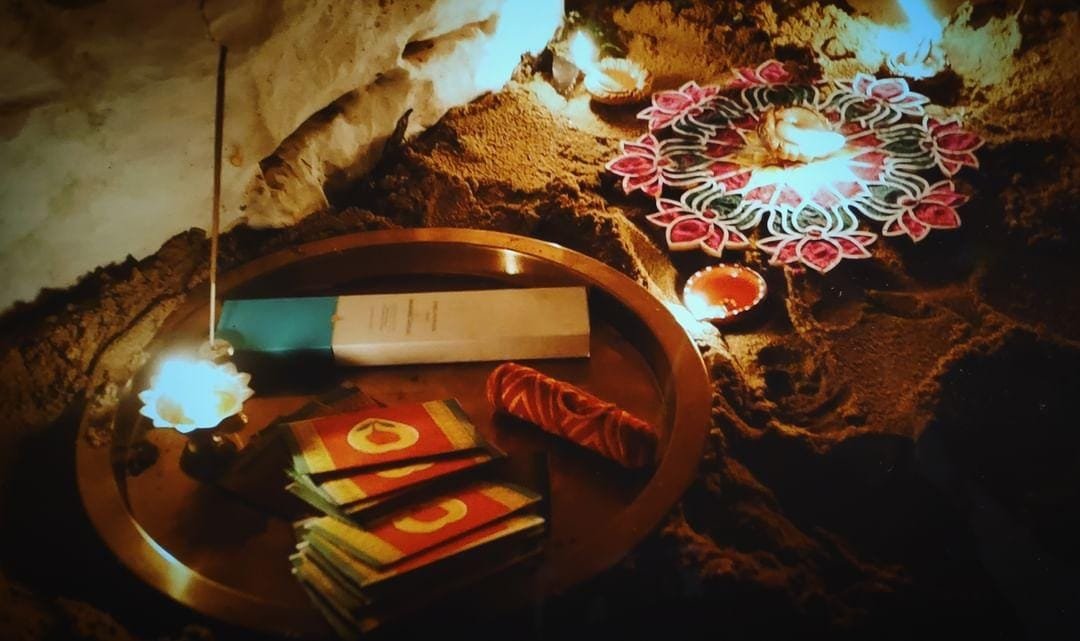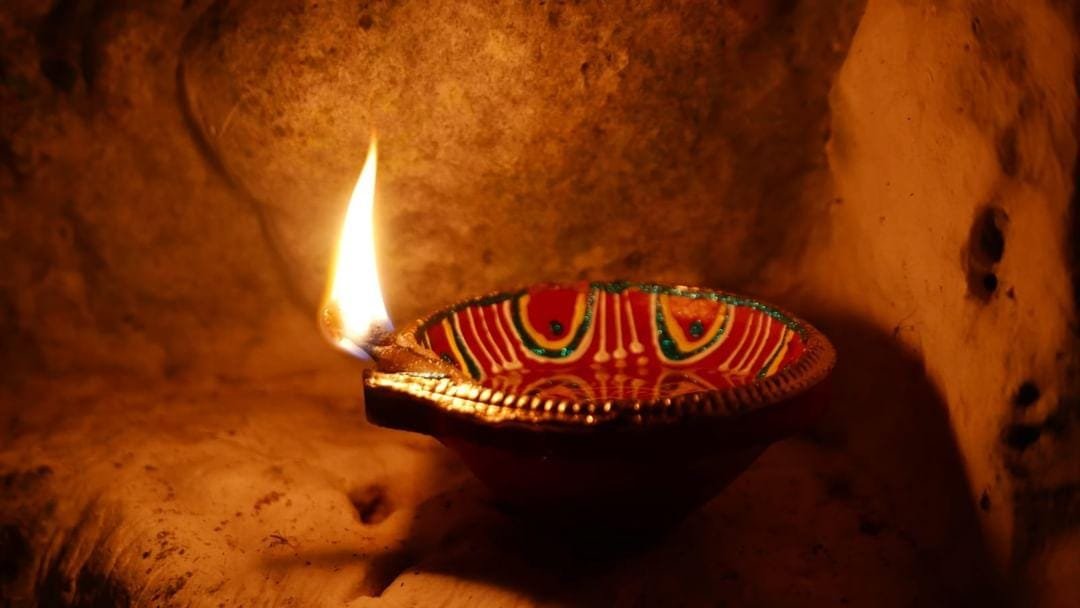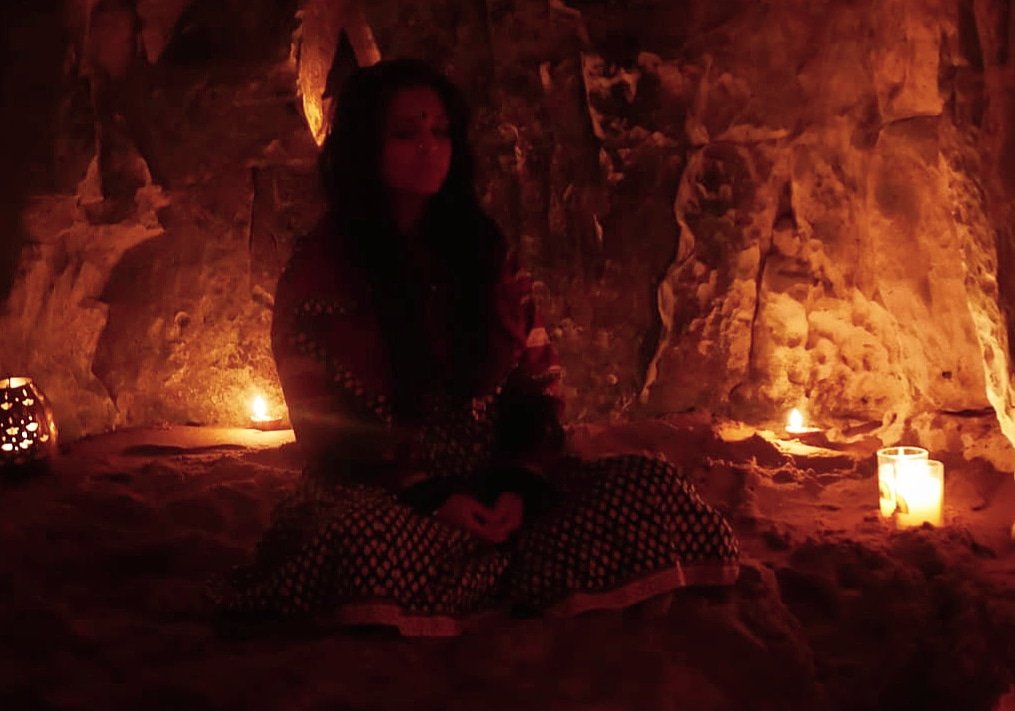Home
2023, an intervention in nature.
Clay lamps, rangoli, ceremonial garlands, incense, blessing envelopes, sound
Home, is conceived as a shrine to nature, and an ode to freedom.
On the night of the new moon of the Hindu festival of Diwali and the Sikh Festival of Bandi Chhor Diwas, and set in a natural chalk cave on the Thanet coastline - diya light (Indian oil lamps), mantra, space, and scent combine, as a shrine to the sacredity of nature in its rawest and freest form.
Illuminated by the sheltered flames of diya light, the cave was filled with 2 soundscapes, originating from the Sikh and Hindu lineages. While also being adorned with the offering of scent in the form of incense.
It was intended to be a soft and soothing womb like space, that evokes both the emotions and the senses. A space to perceive beauty, to reflect, and to feel held.
Participants were invited to bring a natural offering to the altar if they felt called to, and to sit/stand in quiet contemplation, on feelings of warmth, safety and belonging. And, on ideas of freedom, the recognition of Earth as our true home, Earth as our temple, and our personal and collective human journeys towards freedom and light.
Photo credit goes to Dee Ajiba




A Glossary of Things and Ideas
Diyas
A Diya, is a traditional Indian oil lamp made of clay, it is fuelled with ghee/mustard oil, and uses a cotton wick to feed the oil to the flame. In Indian spirituality and mysticism diyas symbolise goodness and purity, and lighting them denotes dispelling darkness and going into light. It is believed that the ghee or oil in a diya signifies negativity in your mind and the wick symbolises the Atma or soul. By lighting the diya, you dispel negativity from your mind and soul. Since Diwali and Bandi Chhor Diwas are celebrated on the new moon, a time of darkness everywhere; lighting these lamps is a means of eradicating darkness.
In this act of place-making I am using diyas I have collected during a number of visits to Punjab during the Diwali holiday period. Diyas that were bought from the local market, and from door to door sellers in the village, who make them at home. These are combined with imported ones that I have bough from Punjabi green grocers here in Kent – a symbol of diasporic identity, assimilation and the striving to create a home-away-from-an-ancestral-home.
Sound Works
In the book ‘The Mysticism of Sound and Music: The Sufi Teaching of Hazrat Inayat Khan’ it says:
“ Why is music the divine art, while all other arts are not so called? We may certainly see God in all the arts and in all sciences, but in music alone we see God free from all forms and thoughts. In every other art there is idolatry. Every thought, every word has it’s form. Sound alone is free from form. Every word of poetry forms a picture in our mind. Sound alone does not make any objects appear before us.”
For this reason, I have selected two soundscapes which use primal mantras. One from the Sikh faith, and one from the Hindu faith (which is recorded using the healing frequency of 432Hz).
The Meaning of Mantra
The word ‘mantra’ directly translates to ‘instrument of the mind’ and comes from the ancient Indian language Sanskrit.
Mantras are a sacred sound technology composed of words and syllables. They impart healing powers for spiritual development, and allow us the potential to experience cosmic alignment with a greater consciousness.
Mantra 1 by Krupa 43Two (18 mins)
Aum
Aum is often chanted 3 times, for peace in the body, peace in the mind, and peace in the spirit.
Aum is chanted to make the past, present, and future more peaceful.
Aum is the sound of creation.
Aum is the sound that sustains the Universe.
Aum produces powerful and positive vibrations, which allow us to feel our union with the whole Universe.
Aum is the mantra that changes our aura.
Aum is related to our third eye.
Mantra 2 by Govinder Singh Akal (15 mins)
ੴ
Eik-Oānkār
The One Primal Harmony: Aum
ਸਤਿਨਾਮੁ
Satinām
The Truth Within Us All
ਸ੍ਰੀ
Srī
Sacred Universe
ਵਾਹਿਗੁਰੂ
Vāhigurū
The all Inspiring who guides us from darkness to light
Numerology and the Run Time of 33 mins
The number 33 is associated with creativity, manifestation, and spiritual growth, all of which can be powerful tools for attracting abundance and prosperity. The number 33 can also be a reminder to trust in the universe and have faith that the resources you need will come to you.
Balance
As with the water and fire elements in the space, I have sought to balance the masculine and feminine energies, through the use of two separate mantras, one recited by male voices and one by a female.
Incense
Burning incense is believed to deepen our attention and empower our spiritual focus. The aroma of incense can help to tap into our spiritual connections. It calms the environment and mind, cleansing the space for inner and outer journeys. Burning incense is also a sign of reverence and dedication. On this occasion I have used incense produced by Temple of Incense, a London based, South Asian female owned, ethical and natural brand.
Rangoli
Rangoli, which means “an array of colours” in Sanskrit, is a traditional Indian art form dating back 5,000 years. It is a multi-coloured floor decoration using a mix of materials such as sand, flower petals, rice flour, lentils and beans. A rangoli is offered as a welcome to guest, symbolises wealth, joy, and prosperity, as well as a thanksgiving to Gods and Goddesses, and deities.
Haar
A haar is the Hindu/Punjabi name given to a garland. Haars were initially used as a symbol of victory, worn by kings after they defeated their enemies. They were later adopted as a symbol of love and respect, used to honour deities, special guests, and used in sacred and auspicious ceremonies. I used a haar in this space as a symbol of honouring, love and respect to Mother Earth.
Diwali and the New Moon
Diwali is a celebration within the Hindu faith. In northern India, they celebrate the story of King Rama's return home to Ayodhya after he defeated Ravana, by lighting rows of clay lamps. On this night it was a new moon, so Diya’s (clay lamps) were lit in celebration and to light his way. Southern India celebrates it as the day that Lord Krishna defeated the demon Narakasura.
Diwali is also known as the Festival of Lights. In the ancient Indian language, Sanskrit, Diwali (or Deepavali) means 'row of lamps'. People light lamps at Diwali to show that light is more powerful than darkness, and good is more powerful than evil, as well as to celebrate new beginnings.
Bandi Chhor Divas
Bandi Chhor Divas is a Sikh celebration that commemorates the day the sixth Guru of Sikhs, Guru Hargobind Ji released 52 prisoners from Gwalior Fort in 1619, who had been imprisoned by Mughal Emperor Jahangir. Emperor Jahangir had held 52 Kings at the Gwalior Fort for several months. Bandi Chhor Divas literally translates to Prisoner Release Date, Bandi Chhor Divas, which celebrates the acts of compassion and selflessness from Guru Hargobind – the 6th of 11 gurus of the Sikh faith – who remained imprisoned to protest for the rights of wrongly imprisoned Hindu princes.
Guru Hargobind was requested by the Mughal emperor at the time, Jahangir, to stay at his fort to perform prayers. However, one of the advisors of Jahangir wanted to keep Guru Hargobind at the fort as a political prisoner as he was such an influential figure.
Guru Hargobind stayed at the fort for many months and during their time there they met many people who were falsely imprisoned and were made to stay in extremely poor conditions. The Guru eventually was asked to leave the fort. However, he refused to leave until the 52 innocent Hindu princes were released from imprisonment.
The emperor reluctantly agreed to the freeing of these princes, but only if they could all hold onto the Guru’s cloak. After this request, the Guru ordered for a cloak to be made with 52 tassels attached for all imprisoned princes to hold onto. 52 innocent Hindu princes were later released from Gwalior Fort.
The Guru and the prisoners returned from Gwalior to Amritsar in India and by the time they arrived at Amritsar many weeks later the celebrations for Diwali were underway.
Sikhs and Hindus celebrate Bandi Chhor as a day of reflection on how we can all learn from this story the values of compassion, selflessness and the importance of community cohesion, and helping others regardless of background, religion or any other characteristics. Something that feels more poignant today than ever.
Faith and Politics
We exist in a time of a lot of division. Divisions are practiced on many grounds. Religion, racialisation, class and gender, are a few that I have experienced personally.
Being a member of the Punjabi-Sikh Indian diaspora in the UK, and having a deep and close relationship with my motherland of Punjab, I am intensely aware of the far-right political leaning of the Indian government and it’s discrimination and harm to the minority religions of Sikhism and Islam.
Religion is often used as a divisive force in politics and propaganda. In my own way I hope to rise above this, taking it back to the pure, wholly inclusive, sacred and divine message of oneness, that both religions are grounded in. Presenting the untouched Earth, as the temple indiscriminately, abundantly, and generatively, hosting and serving humanity as One.
Geography
Why a cave? Why the Thanet coast?
I have chosen to place this work in a cave, as it provides a beautiful metaphor for the incubation, safely, protection, and physical and spiritual sustenance offered by the womb.
Thanet has also had a long history of affiliation with racist leadership and politics, so taking up space using sacred Sikh and Hindu mantras, in a fully natural and accessible place, feels revolutionary somehow.
Temples can unintentionally create barriers for visitors who do not identify as belonging to that faith. This temple-like shrine to spirituality and nature, is designed with the intention that it is for anyone (human or animal) that feels called towards to it.
The sea as a backdrop, is a perfect accompaniment to the fire element used to light the cave. The natural rhythmic nature of the tides echo the energies of the moon, and offer soothing energy and sound vibrations to those that share commune with it.
